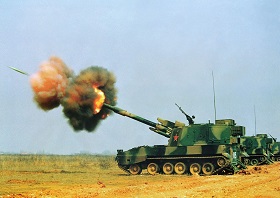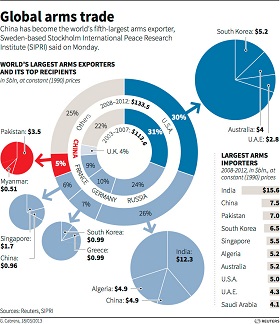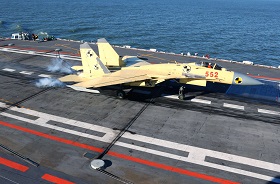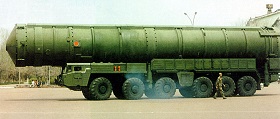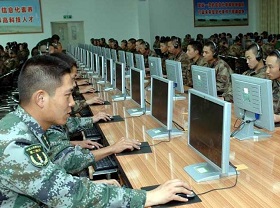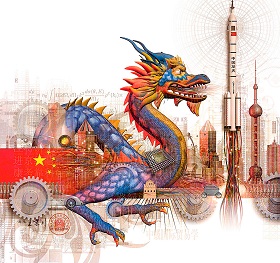For a long time China's military rise had been overshadowed by its economic boom. But in recent years the country has achieved a qualitatively new level in its forces’ equipment and organization levels, with the People's Liberation Army (PLA) becoming a fully modern military entity able to wage a technologically advanced war and project force a great distance from China's borders.
Since the mid-2000s the Chinese armed forces have been undergoing a radical transformation, possibly unlike any seen in their entire history, which promises to redefine it, moving away from the previous numbers-based model of an Army manned mostly by peasants and focused on ensuring national defense by outnumbering the enemy and being able to mobilize rapidly.. In contrast, China is striving to develop high-tech force equal in training and equipment to those of United States and Japan – the countries that are regarded as its main potential enemies.
This new Chinese force will be capable of projecting its power globally using a blue-water fleet, strategic military transport aviation, and potently mobile Air Force. The deadline for the PLA's transformation into a new generation fighting force has been set for 2020, after which China will continue building up its capabilities. By 2020, Beijing plans to have achieved "major modernization successes" and by 2050 it should become fit to win wars waged with use of information technologies.
China's New Soldiers
The PLA's social structure is also changing, with the previous image of a Chinese soldier as coming from a large family being relegated to history. Most of today’s servicemen are only children born under the "one family – one child" policy, and many come from cities [1].
This social change entails a switchover of the broader approaches to how personnel are treated and managed – their material security, motivation, how service is managed, and the training methods used. The top brass views this new environment as both engendering problems (effeminacy or softness, and the lack of discipline among soldiers) and opportunities (better education, more initiative). The soldiers of today are better prepared to operate modern weapons systems and over time will be more intellectually engaged with the orders they are following, although their adaptation to the military service proves more problematic than that of their predecessors.
The formation of the PLA officer cadre also differs from previous practices, with more university graduates enrolling thanks to a special training program developed in 1998 on the basis of the U.S. ROTC system (Reserve Officers’ Training Corps) currently involving 117 higher education establishments [2]. Back in 2000, in the early days of the program, Chinese leaders expected its graduates to account for over 60 percent of the annual influx of new officer recruits by 2010. This level has yet to be reached, and in 2009 the figure was just 30 percent and must have somewhat grown until today. Alongside this improved educational and cultural background, the Chinese military are enjoying increasingly better pay and service conditions. The PLA boast a new life and health insurance scheme that substantially improves social protection of the servicemen and their families, a major issue until recently. At least since the mid-2000s, military salaries are growing faster than the country’s average. From 2006 to 2011, officer’s average monthly pay more than doubled, reaching 5373 renminbi, i.e. about USD 840. At the same time, these figures are still not exactly competitive with the private sector, which is compensated by better social protection of the military and the armed forces’ role as one of the most powerful social lifts in Chinese society.
Beijing is currently reviewing the structure of its armed forces, with regiments and divisions gradually being eliminated in the Army and the Air Force. Combat training has been focused on the interaction of arms and services using up-to-date computerized systems. The armed forces are also acquiring precision weapons, in part in order to improve the performance of outdated systems, for example the artillery is obtaining 122 and 155-mm guided ammunition with extended range. In the air force, pilot training offers increased flying hours (200 hours a year for fighter pilots on average) [3] and sophisticated programs focused on developing the pilot’s ability to take decisions without ground assistance.
Technological Revolution
Whereas in the 1990s and 2000s Beijing officially recognized its considerable technology lag behind industrialized states, in 2009 this rhetoric changed. The Chinese defense sector has managed to close the gap with leading arms and military equipment manufacturers in most areas, skipping one or two generations in defense technology development. However, quality is still a major bottleneck against the backdrop of fast growing salaries and end product prices. Another weak spot is dependence on the import, mainly from Russia, of basic components for advanced weapons systems, such as engines, target seekers, etc.
The growing Chinese defense industry potential can also be felt via the expanding geography of its arms exports. In recent years, China has become a major weapons vendor, with most sales going to countries whose choice of partner for military-technical cooperation is restricted (over 50 percent to Pakistan). At the same time, certain Chinese systems, for instance PLZ-45 155-mm howitzers, are sufficiently advanced to enter the competitive markets of rich oil states in the Middle East including Kuwait, Saudi Arabia and Algeria.
China is already at the forefront of some areas critical to the global strategic balance of forces such as anti-satellite weapons programs that match the world leaders in scale and ambition. In addition to systems to counter low-orbit reconnaissance satellites, the Chinese are also working on means to be used against GPS satellites on high geosynchronous orbits that are unlike anything else currently on the market. Large-scale R&D is underway in the missile defense area, including flight-testing of a system to intercept ballistic missiles in both the terminal phase and midcourse.
The PRC is the second country after the United States to launch independent construction of a large family of surface battleships equipped with a multipurpose weapons system: the Project 052D destroyer. The first ships are currently undergoing sea trials. These are fitted with multi-function vertical launchers for several missile types (anti-aircraft, anti-ship and anti-submarine), as well as cruise missiles intended against ground targets. China is the only country simultaneously implementing two fifth-generation fighter programs, both of them at the flight-testing stage.
Strategic Potential on the Rise
Although China seems to be sticking to its traditional stance of minimum nuclear deterrence and has about 250 deployed nuclear warheads, its delivery vehicle development programs are huge. Therefore, one may also expect a change in the development paradigm for China’s strategic nuclear forces, with the initial shifts already at hand. Until recently, China’s strategic nuclear forces had been concentrated in the PLA 2nd Artillery Corps – the Navy having only one practically unfit Project 092 SSBN never used for combat patrol. Delivery aircraft and nuclear bombs had also been few. Base 22, responsible for the storage and servicing of nuclear warheads was transferred to the 2nd Artillery Corps in late 1960s.
China is completing construction on the first of planned five Project 094 SSBNs to be equipped with new JL-2 solid-propellant ICBMs. The U.S. Department of Defense expects its maiden voyage as soon as this year. The abrupt growth of the Navy’s role and the switch of delivery means to combat patrol indicates a revised approach to employment of the Chinese nuclear arsenal.
More new developments seem to be in the pipeline. As of now, the PLA has deployed over 35 DF-31 and DF-31A mobile sold-propellant ICBMs [4], with development of the advanced multiple-head version underway [5]. One more element, the DF-41 [6] heavy solid-propellant ICBM is being flight-tested. Other development projects include new-generation medium-range ballistic missiles and advanced ballistic missiles for submarine use.
Although the inevitable buildup of the Chinese nuclear arsenal has been officially recognized, it seems too early say how far the process will go. But China will undoubtedly catch up with Russia and the United States in the diversity and technology level of its nuclear delivery means, outclassing all other nuclear states. While France and Britain retain only the naval nuclear component, China is on the way to creating a full-fledged nuclear triad incorporating at least two types of basic ICBMs, SSBNs, and strategic aviation.
War on the Web
China’s military leaders attach a lot of attention to information warfare, especially since the U.S. and allied forces are critically dependent on their ramified information networks. A successful assault on military and civilian control and communications systems may be sufficient to disrupt an enemy attack and even prevent the active stage of a military conflict. Outlined in the late 1990s by Chinese military strategists, the concept of integrated network electronic warfare suggests the combined use of electronic warfare and computer network attacks with the hard-kill of information structure including satellites. Electronic warfare and computer attacks are under the 4th Department of the PLA General Staff that has been booming in recent years – expanding its personnel, making technological advances and creating more centers for training information warfare experts. Signal and electronic intelligence is handled by the General Staff’s 3rd Department, which lists as many as 130,000 personnel and possesses an expanding network of stations in China and presumably overseas, and is fast becoming a major issue in U.S.-China relations.
A Global Force
Although the PLA is basically a ground force – 1.6 million of the total 2.29 million – in recent decades the Army's strength and clout have been on a downward spiral. Most funds are channeled to the Navy and the Air Force, chiefly because of their rising mobility. Destroyers equipped with cruise missiles are to join carrier attack groups. China has already commissioned its first aircraft carrier Liaoning that came about through the completion of the Soviet guided-missile cruiser Varyag¸ while two more carriers are under construction to modified designs. In future, China intends to switch over to the construction of nuclear-powered carriers with electromagnetic catapults matching U.S. equivalent models. Amphibious forces are also growing fast, construction work on type 071 amphibious transport docks is in progress and that on the Type 081 all-purpose landing ship is at blueprint stage. China is buying IL-76 heavy military transport aircraft and IL-78 tankers in Russia, Belarus and Ukraine, and also working on its own Y-20 heavy transport [7], in order to obtain about 100 heavy transport aircraft and hence the capability to airlift an infantry division to any spot on the globe.
Beijing's goal seems to lie in making the PLA capable of projecting force to distant regions of the world by the end of this decade. The need comes from the fact that China is becoming the world's second largest economy engaged in international division of labor and vigorous investment abroad. Chinese FDIs, which account for over USD 400 billion, and worforce in volatile countries of Africa, the Middle East and Latin America, are constantly growing, leaving the country's leaders no other choice. China views Russia as a critical partner in the approaching battle with the United States for global leadership. At the same time, China's foreign and defense policies are still largely focused on countering U.S. attempts to contain its political and economic expansion by surrounding the rising power with a network of military alliances and military bases. And it is the need to respond to these matters that is shaping Beijing's current priorities in military building.
International Response
The PLA's modernization has become both a headache and a critical motive for the U.S. forces to step up their own upgrading, and the same is true of other Asia-Pacific countries including Japan and Vietnam. Washington began revising its force development to account for China's rise back in 2005, when the administration of George Bush Jr. decided to make the Pacific Ocean home to the 60 percent of its nuclear-powered submarines and deploy another aircraft carrier. In 2012, President Obama announced the pivot to Asia, only to indicate that the United States is bolstering its forces in the region, stepping up cooperation with regional powers and expanding the military infrastructure. China's nuclear ambitions are also attracting widespread attention, although they remain in their infancy and have not become a major irritant in relations between China and the United States.
The growing U.S. involvement in the region's affairs and fears about Chinese military power have added tensions to the traditional territorial disputes between China and its neighbors, i.e. Senkaku/Diaoyu Islands in the East China Sea with Japan and the Parcel Islands and Spratly Islands in the South China Sea. As it moves toward military modernization and though its stance on territorial disputes remains tough, China is so far avoiding acute conflicts, including through substantiating its presence in the disputed areas by unarmed Coast Guard ships rather than the Navy.
1. Currently, over 54 percent of China’s total population resides in cities, while urbanization continues to rise, bringing this figure to an estimated 60 percent in 2018 (http://www.reuters.com/article/2013/12/27/china-urbanization-idUSL3N0K607G20131227)
2. Bo Zhiyue. The PLA Young Cadet Development: Defense Students Program. East Asian Institute, National University of Singapore, 2011.
3. R.Halloran. A Revolution for the China Air Force. Air Force Magazine, February 2012
4. The Military Balance 2014
5. Is China Preparing MIRVed ballistic missiles? The Diplomat, 08/08/2014
6. China Confirms New Generation Long Range Missiles. AFP 01/08/2014
7. Zhongguo Qingnian Bao newspaper, January 18, 2013.


